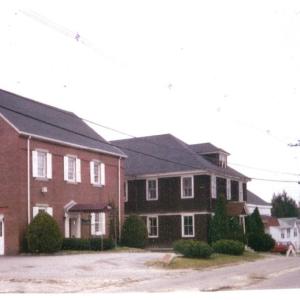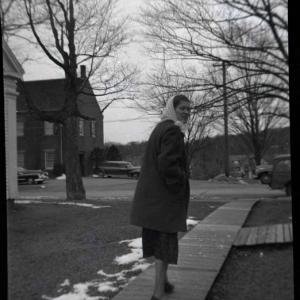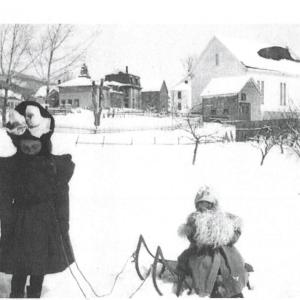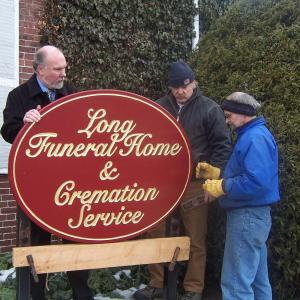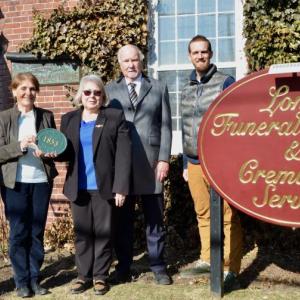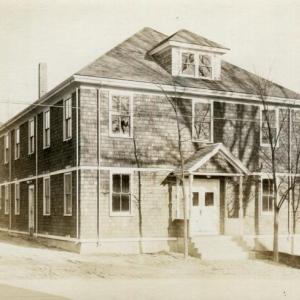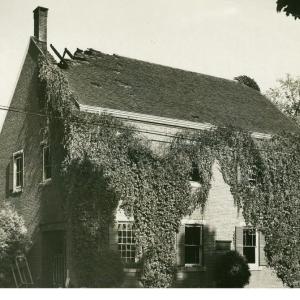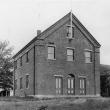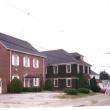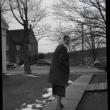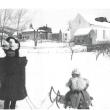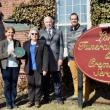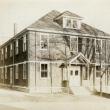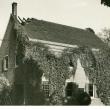The remarkable history of the Camden Brick Schoolhouse on Mountain Street
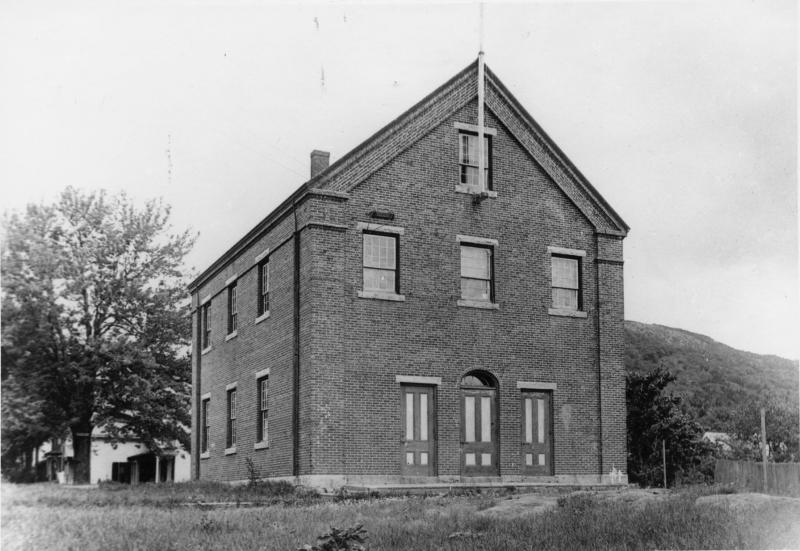 The school house, built in 1863, with a rich history that continues through today. (Photo courtesy Camden Historic Resources Committee)
The school house, built in 1863, with a rich history that continues through today. (Photo courtesy Camden Historic Resources Committee)
 The Long Funeral Home, with bunting. (Photo courtesy Long Funeral Home)
The Long Funeral Home, with bunting. (Photo courtesy Long Funeral Home)
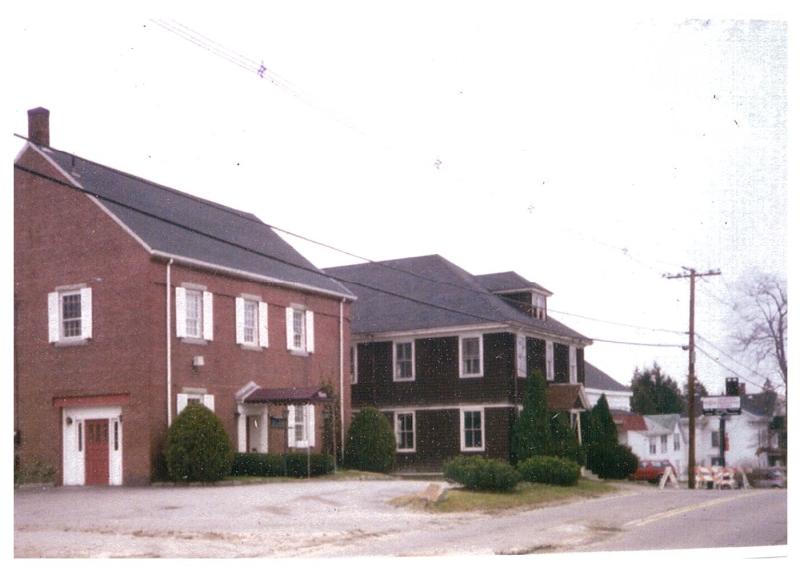 The funeral home, next to the Grange. (Image courtesy Long Funeral Home)
The funeral home, next to the Grange. (Image courtesy Long Funeral Home)
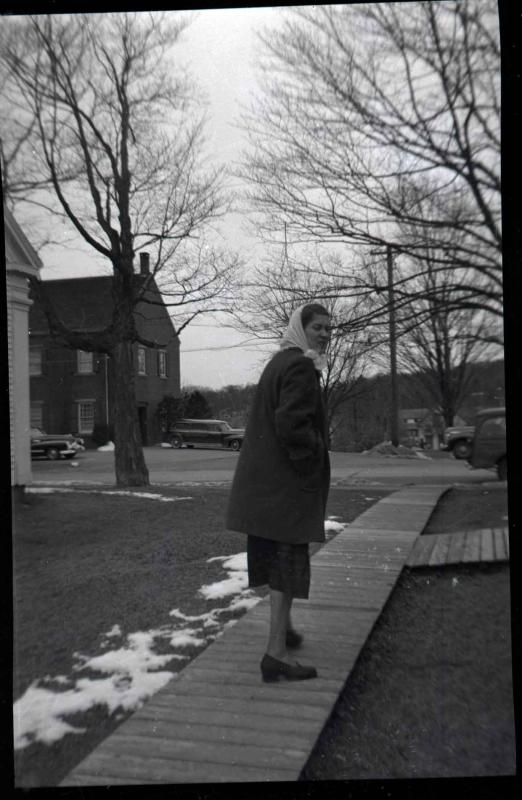
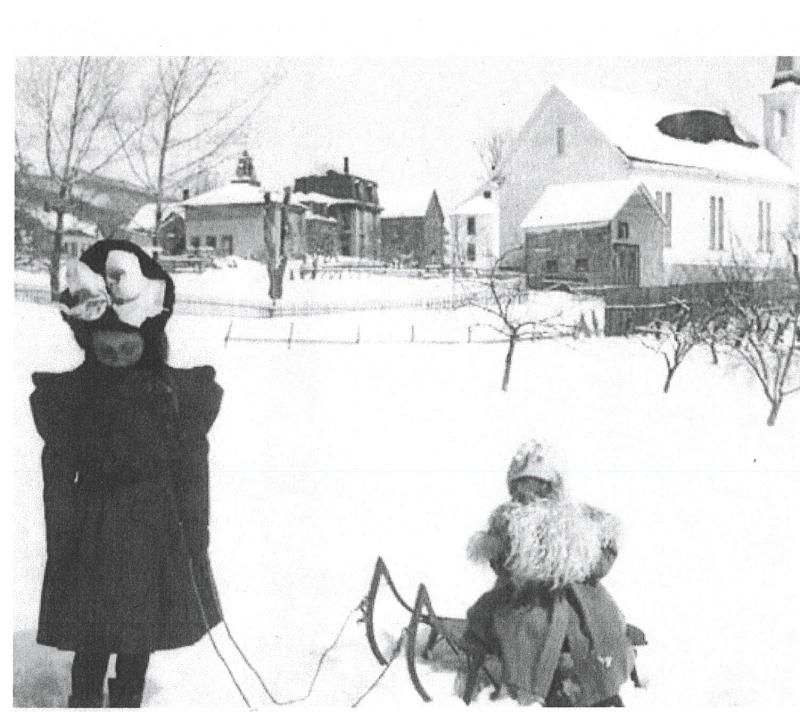 An old photo of the school house next to the grange. (Photo courtesy Long Funeral Home)
An old photo of the school house next to the grange. (Photo courtesy Long Funeral Home)
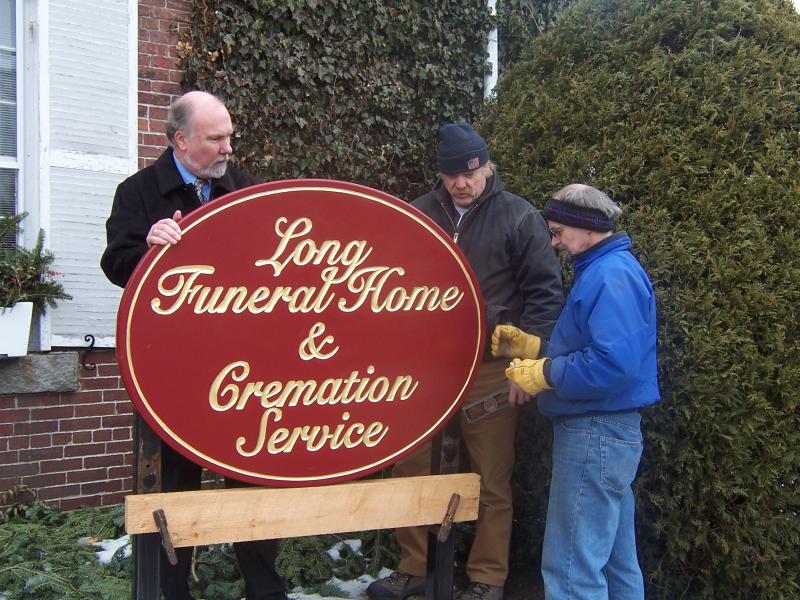 The installation of the Long Funeral Home sign with John Long, John Long, Walt Simmons, owner of Ducktrap Woodworking and who made the sign, and Bill Clement. (Photo courtesy Long Funeral Home)
The installation of the Long Funeral Home sign with John Long, John Long, Walt Simmons, owner of Ducktrap Woodworking and who made the sign, and Bill Clement. (Photo courtesy Long Funeral Home)
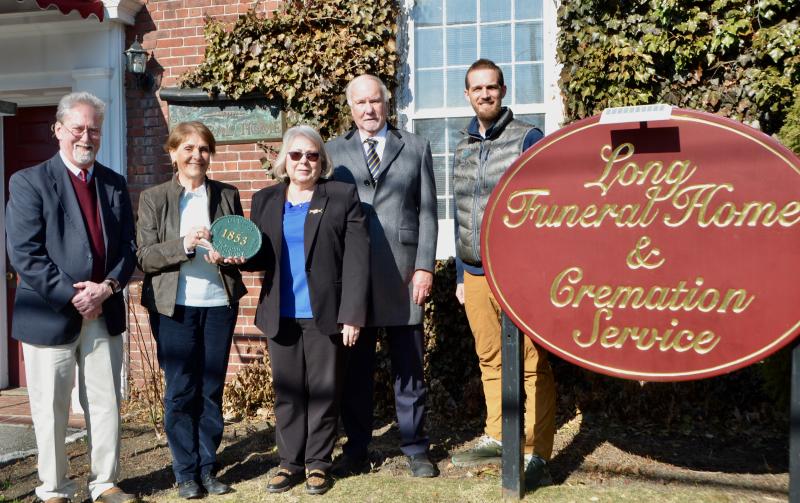 On March 23, The Camden Historic Resources Committee presents an historic landmark plaque to the Long Funeral Home to place on the outside of the old school house, built in 1853. From left to right: John Laite, Pat Skaling, Julie Clement, John Long and Will Addis, Chair of the Historic Resources Committee. (Photo by Lynda Clancy)
On March 23, The Camden Historic Resources Committee presents an historic landmark plaque to the Long Funeral Home to place on the outside of the old school house, built in 1853. From left to right: John Laite, Pat Skaling, Julie Clement, John Long and Will Addis, Chair of the Historic Resources Committee. (Photo by Lynda Clancy)
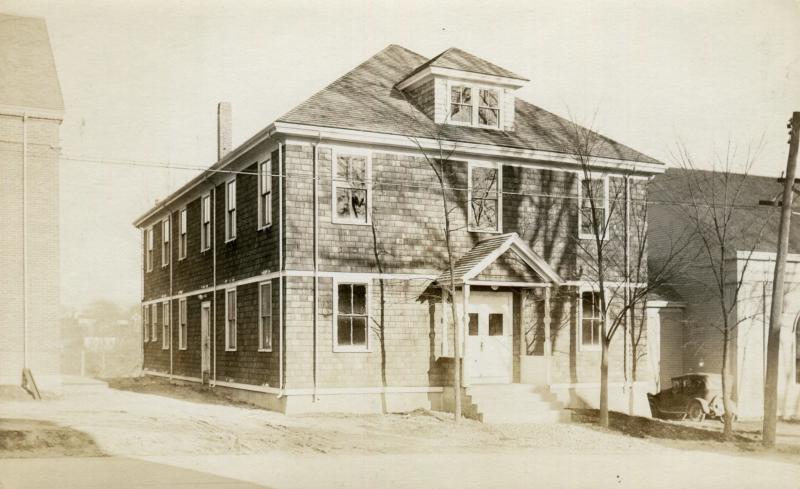 Megunticook Grange. The brick schoolhouse is to its left. To the right, High Mountain Hall. (Image courtesy Camden Historic Resources Committee)
Megunticook Grange. The brick schoolhouse is to its left. To the right, High Mountain Hall. (Image courtesy Camden Historic Resources Committee)
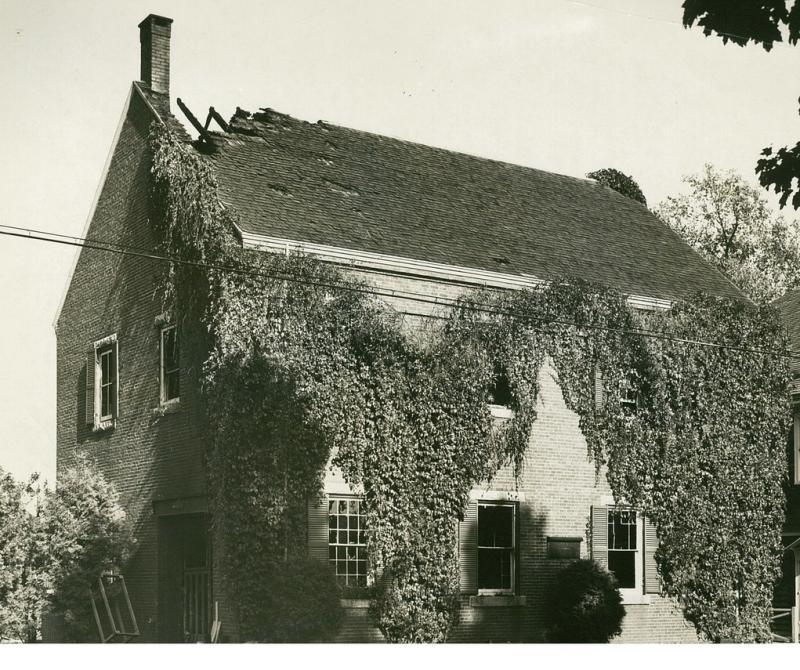 The funeral home after the fire of 1950. (Image courtesy Camden Historic Resources Committee)
The funeral home after the fire of 1950. (Image courtesy Camden Historic Resources Committee)
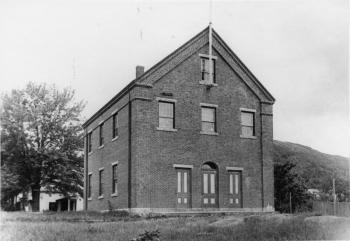 The school house, built in 1863, with a rich history that continues through today. (Photo courtesy Camden Historic Resources Committee)
The school house, built in 1863, with a rich history that continues through today. (Photo courtesy Camden Historic Resources Committee)
 The Long Funeral Home, with bunting. (Photo courtesy Long Funeral Home)
The Long Funeral Home, with bunting. (Photo courtesy Long Funeral Home)
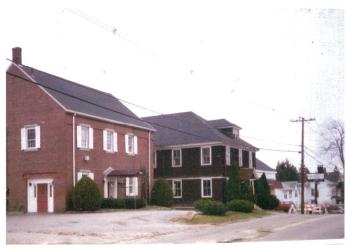 The funeral home, next to the Grange. (Image courtesy Long Funeral Home)
The funeral home, next to the Grange. (Image courtesy Long Funeral Home)
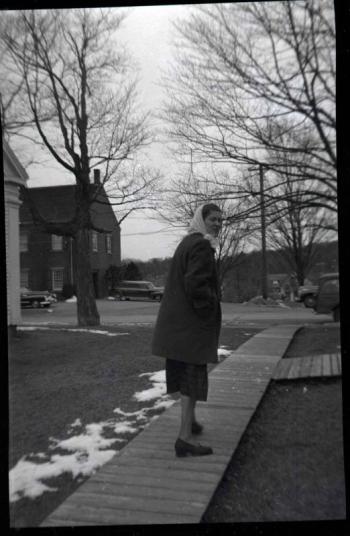
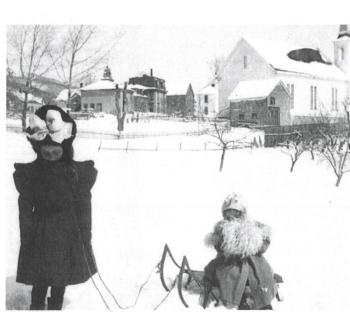 An old photo of the school house next to the grange. (Photo courtesy Long Funeral Home)
An old photo of the school house next to the grange. (Photo courtesy Long Funeral Home)
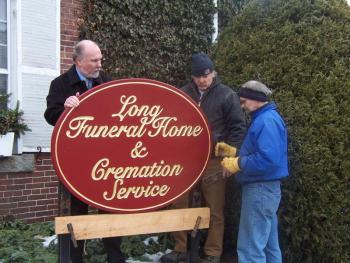 The installation of the Long Funeral Home sign with John Long, John Long, Walt Simmons, owner of Ducktrap Woodworking and who made the sign, and Bill Clement. (Photo courtesy Long Funeral Home)
The installation of the Long Funeral Home sign with John Long, John Long, Walt Simmons, owner of Ducktrap Woodworking and who made the sign, and Bill Clement. (Photo courtesy Long Funeral Home)
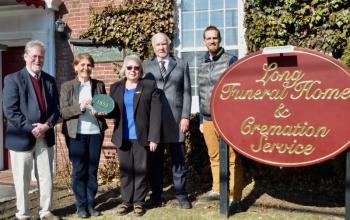 On March 23, The Camden Historic Resources Committee presents an historic landmark plaque to the Long Funeral Home to place on the outside of the old school house, built in 1853. From left to right: John Laite, Pat Skaling, Julie Clement, John Long and Will Addis, Chair of the Historic Resources Committee. (Photo by Lynda Clancy)
On March 23, The Camden Historic Resources Committee presents an historic landmark plaque to the Long Funeral Home to place on the outside of the old school house, built in 1853. From left to right: John Laite, Pat Skaling, Julie Clement, John Long and Will Addis, Chair of the Historic Resources Committee. (Photo by Lynda Clancy)
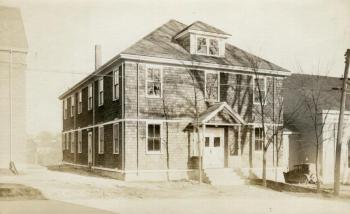 Megunticook Grange. The brick schoolhouse is to its left. To the right, High Mountain Hall. (Image courtesy Camden Historic Resources Committee)
Megunticook Grange. The brick schoolhouse is to its left. To the right, High Mountain Hall. (Image courtesy Camden Historic Resources Committee)
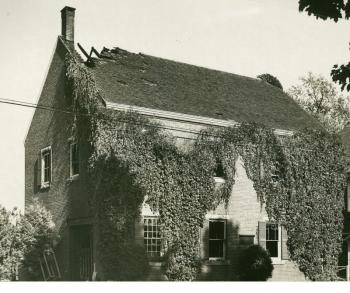 The funeral home after the fire of 1950. (Image courtesy Camden Historic Resources Committee)
The funeral home after the fire of 1950. (Image courtesy Camden Historic Resources Committee)
According to Reuel Robinson in his 1907 History of Camden and Rockport Maine, the brick school on Mountain Street in Camden, was built in 1852-53 as a district schoolhouse. The new school took the place of a demolished, one-story, brick “district school house with a quaint little porch appended for an entry,” which had previously stood on the site. (Robinson p.597)
The bricks from the original school building were reportedly used in the construction of the new schoolhouse which, at the time, was considered the finest school building in town. It had green blinds, black walnut desks mounted on iron pedestals, something before unknown, and the district residents were so pleased with the building that they voted at their district school meeting not to admit scholars from outside districts. Later, in 1855, this vote was rescinded. (Robinson p.597)
It is possible the bricks for the building came from the Hemingway Brickyard on Mechanic Street since it was in operation at the time and supplied many of the bricks for the early buildings in Camden. (Camden Herald Souvenir Edition, August 18, 1951). The only other local brick maker in Camden, mentioned by historian John Locke in his 1859 listing of in-town tradespeople and businesses, was W. T. Collins. (Locke p.258). It seems probable the bricks were locally made in Camden.
Although the Mountain Street schoolhouse was not the earliest school in Camden, it is one of only two early Camden school buildings extant. It is remarkable that the building is almost 170 years old and still in useful operation, although no longer functioning as a school.
The Mountain Street school served as a school from 1853 to 1905. Indication of early building repairs were found in the handwritten notes of Old Records of Megunticook School District, Camden, Me: March 15, 1880-1894, which mentions Article 6 of the Town Warrant in 1887 asking for tax money to repair the brick school on Mountain Street. Voting on the warrant issue occurred on March 21, 1887, and the sum of one hundred dollars was approved by Camden citizens for the school repairs.
Over the years, the Brick schoolhouse, as it was called, served as an ungraded district school and later as a graded school, mostly for primary and intermediate grades. The following are some interesting details found in various sources that give glimpses into the school’s past.
In the Annual Town Report of 1893, the school was described as follows:
“Mountain Street Intermediate This school has been under the efficient instruction of Miss Georgia Haskell. The best order has been maintained, and during the past year her school has maintained the high standing it had attained during the preceding year.”
“Mountain Street Primary Taught by Miss Mary Bowers. Miss Bowers is a hard worker and possesses most excellent tact in imparting instruction. An examination of her classes shows that most excellent progress has been made.” (Second Annual Report of the Selectmen of the Town of Camden for the Year ending March 20, 1893; p. 29)
Although Mary Bowers, mentioned above, appears a commendable teacher, it is interesting to note her salary in 1893 was increased by only fifty cents, and by 1899 she was earning a meager $10.00 per week.
In the Fifth Annual Report of the Selectmen of the Town of Camden for the Year ending March 1896, two schools were listed as primary schools: Elm Street and Mountain Street. The Mountain Street primary was described as under “the faithful and efficient direction of Miss Mary Bowers, who has succeeded admirably in bringing her school up to a high standard by the use of new methods. The introduction of some of the principles of kindergarten system in these two schools [Elm St. and Mountain St.] has been a new feature in the school work. It has been attended with success... There has been one new school building added to our number the past year.” This was the new Millville School.
In the same 1896 report, the district schoolhouses were described as “in fair repair.” The report then detailed the following: “the rooms of the Elm st. and brick school houses have been thoroughly cleansed and the ceilings whitewashed…. New floors are much needed in the Grammar, Intermediate and Primary rooms on Elm st. and also in the Brick school house, those in the latter are much worn, and in some places worn through, in all of these much dirt and filth accumulates, and it is a source of great discomfort and annoyance, and there is always a liability when such a condition exists, for the seeds of disease to lurk and at a time least expected, an epidemic may arise, and spread through the schools. There is need also of new water closets at the Brick School House, those in use are inadequate and a reproach. Temporary repairs were made last season just to tide them over.”

In the following year, in the Sixth Annual Report of the Town Officers of the Town of Camden, March 15, 1897, the Superintendent of School’s report stated: “Owing to sickness we considered it advisable to close the winter term abruptly in the Elm and Mountain street schools, in the tenth week; but the spring term will be lengthened sufficiently to make out the full number of weeks for the year.” Thos. A. Hunt, Superintendent. (p 27)
In the 1898 Seventh Annual Report of the Town Officers of the Town of Camden, Thos. A. Hunt, Superintendent, informs that a new closet for the boys [I believe he is referring to a water closet] and a coal shed have been built at the Mountain Street school house taking the place of the old one which was unfit for use. (p 38)
The Eighth Annual Report of the Town Officers of the Town of Camden, March 11, 1899, contained the report of the Superintendent summarizing that the school buildings, “now in use are in fair condition except the brick school house, and it is my opinion that the town had better not waste any more money in making repairs to a building so old and inconvenient for the use of modern schools, but should sell the building and lot and put the money into a better located and better designed building.” He added that new desks were added this year for grade 5 and new windows were installed on the east side of the building, but to make the building “what it ought to be,” he stated it would be as expensive as building a new schoolhouse. (p 39)
At a meeting of the School Board on December 21, 1904, Board members J.H. Ogier, Reuel Robinson, and D.W. Pierson voted to close the Brick school house and put grades one and five in the new school building on Knowlton Street. In 1905, with the existing Elm Street classrooms along with four new Knowlton school classrooms, there were enough classrooms to discontinue using the brick building as a schoolhouse.
Although the brick school was discontinued in 1905, it appears the town was reluctant to sell the building because according to the report of the 1910 Town Meeting, “Article 28, Relating to selling the Brick school house,” the article was passed over. Whatever the reasons, the town held onto the school building for many years and rented it to the newly formed local Grange unit.
The Brick Schoolhouse as Megunticook Grange Hall
According to the meeting minutes of the Megunticook Grange No.423, established in 1903, the organization rented the brick building for many years as their meeting hall, even as early as 1903, but as the building was still being used as a school through 1905, the details of this arrangement are unclear. Perhaps the Grange used the second floor, and the school was contained on the first floor or perhaps evening meetings did not interfere with day classes. Whatever the arrangement, Grange minutes show for the years 1903 through 1905 that the Grange often met in the brick schoolhouse. They also met in the Fireman’s Hall and at the same time were looking for lots and/or buildings to purchase for a new Grange home. (Book 1903-1905, Book 1, Megunticook Grange Records)
On March 8, 1905, Grange members voted to accept a lease with the Town of Camden and to spend money to fix wiring and purchase building materials and fixtures for the schoolhouse. Their rent to the Town of Camden was $37.50 every six months, and they paid real estate taxes of $6.94 +/- annually.
It was not until April of 1928, that the Selectmen and the Megunticook Grange No. 423 agreed to an exchange of properties. The Town would exchange the old brick schoolhouse and lot plus $500 in cash for a lot the Grange owned on Pleasant Street.

In April after the sale and deed exchanges, the Grange Building Committee reported the results of a Mr. Hatch’s examination of the brick building and his estimate of repair costs and the cost of building an addition. He estimated costs around one thousand dollars but noted plans under consideration were not yet complete. At their meeting two weeks later, a Bro. Davis reported that the blueprints and price for a new building would be ready next Wednesday, and he made a motion to raze the existing brick building and erect a new hall. Motion was tabled.
For the next few Grange meetings in May 1928, much discussion ensued regarding lots available on Washington St., Knowlton St., and other locations for prices ranging from $250 to $550 as Grange members wrestled with the question of a new building.
It was finally agreed and voted at a June 27, 1928, meeting to approve a previously tabled motion by Bro. Hopkins that the Grange, “build a new hall between our present brick building and the Camden Farmers Union property and so placed as to leave a driveway from the present C.F.U. driveway at our line, around the proposed building, and south of the present brick building to Mountain St. and that the present brick hall with land north of a line 5 feet south be sold for the highest satisfactory cash offer.”
Ultimately, the Grange chose to divide the schoolhouse property acquired from Town of Camden into two parcels: on one parcel they constructed a fine new Grange meeting hall; the other parcel, containing the brick school building, they sold to Percy Good, who converted the school building into a funeral home. Today, the parcel sold to Percy Good still retains the former brick school structure, now the Long Funeral Home.

The new Megunticook Grange Hall was sandwiched between the former schoolhouse and the Camden Farmers Union building. The building served as the home of the Megunticook Grange from its construction in 1928 until it was demolished April 13, 1994, to create a parking lot.
The Brick Schoolhouse as a Funeral Home
After Percy Good’s death in 1933, his widow Arlettie Good continued the business, advertising in the Camden Herald as Mrs. P.J. Good, Undertaker. Arlettie eventually sold the business and building to Gilbert Laite in 1944. (Camden Herald, Oct. 19, 1944) It has changed ownership a few times since 1944 but has continued as a funeral home. [See deed conveyances.]
When John Long and Julie Clement acquired the brick building in 2001 from Andrew Pratt, the building was in terrible shape. After major repairs and careful renovation, it was successfully restored retaining its historic exterior, and it has continued as a funeral home. The interior has been much altered; few of the original classroom details are found, but the exterior looks much the same as it did in 1853.
The Brick Schoolhouse Endures
While many other school buildings have been built and subsequently demolished during the tenure of the Mountain Street School, the so-called “brick school” has somehow endured. It has survived the following challenges:
- In March 1899, Superintendent Thomas A. Hunt in his report to the Superintending School Committee recommended selling the building as it was in such poor condition. Had it been sold; it might have been demolished.
- It also might have been destroyed when, as reported in the July 14, 1911, Camden Herald: “A heavy thunderstorm and squall struck here early Thursday afternoon. For a few minutes the wind blew a gale but not enough to do any special damage. Lightning struck the chimney of the old brick schoolhouse on Mountain Street occupied by Megunticook Grange #423...”
- In 1928, after purchasing the schoolhouse, the Megunticook Grange considered razing the building and using the proceeds to build a new hall elsewhere. The motion did not pass.
- In 1950, the building survived a fire started by a flooded oil burner on the first floor. The fire burned up through the second floor and the roof but was fortunately contained in one part of the building. Such devastation could have persuaded the owners to demolish it.

Today, almost all the old district school buildings are gone; the 1820 yellow schoolhouse gone, moved from Elm to Mechanic Street, used for a block mill, and later burned; the 1868 yellow school on Elm Street gone, lost in a fire; the mid-1800 red district schoolhouse on Belfast Road gone; the 1895 Millville School and other district schools named Cobb, Hodgman, Mansfield, Bramhall, and Barnes all gone; the 1905 Knowlton St. High School and the 1957 Camden High School gone, along with the 1970 Rockport Elementary School.
Due to good fortune, sturdy construction, conservation, and preservation-minded stewards, the classic historic brick school building on Mountain Street, remarkably, has survived.
DEED HISTORY FOR MOUNTAIN STREET BRICK SCHOOL HOUSE
Nov. 1, 1819 John Pendleton* conveys to son Arthur Pendleton ¼ of Lot 75 in the first division of lots in the town - a total of 80 acres (WHL Bk 21, p. 522-524)
Sept. 5, 1822 John and Arthur Pendleton convey to the Inhabitants of School District Number Fourteen** “a certain lot of land for the purpose of erecting a School house.” (WHL Bk 23, p. 106)
Sept. 21, 1827 Arthur Pendleton, in a deed conveying ¼ of Lot 75 containing 80 acres to half-brothers Henry Pendleton and George Pendleton and half-sister Elisha Pendleton, excepts from the deed “the lot upon which the brick school house now stands”. (WHL Bk 27, p. 473)
April 2, 1928 Inhabitants of Camden via Selectmen convey to Megunticook Grange the land and brick schoolhouse building for $500 and title to the “Myrick” lot on Pleasant St. (Bk 214, p. 121)
Sept. 19, 1928 Megunticook Grange, Inc., #423 conveys to Percy J. Good a portion of the lot and the brick schoolhouse building (Bk 214, p.197)
Oct. 5, 1944 Arlettie S. Good widow of Percy Good conveys to Gilbert C. Laite. (Bk 281, p.351)
Jan. 28, 1947 Dorothy S. Laite receives from will of Gilbert C. Laite (Bk 290, p. 17)
Dec. 31, 1949 Dorothy S. Laite conveys to Robert E. Laite 1/3 interest (Bk 307, p. 474)
Dec. 30, 1950 Dorothy S. Laite and Robert E. Laite convey to Gilbert C. Laite Funeral Home (Bk 317, p. 440)
June 28, 1984 GCL Liquidating Corporation (formerly Laite Funeral Home, formerly Gilbert C. Laite Funeral Home) conveys to Penobscot Bay Funeral Services: Robert E. Laite, Sr, President (Bk 968, p. 78-79)
Nov. 20, 1987 Penobscot Bay Funeral Services, J. Daniel Fortin, President, conveys to Andrew Pratt (See Bk 2562, p. 62)
Aug. 7, 2000 Foreclosure by Key Bank of Andrew Pratt (Bk 1228, p. 245)
Feb. 5, 2001 Release by Key Bank to Robert E. Laite, Jr, Julie K. Clement, and John R. Long (Bk 2562, p. 62)
Oct 31, 2006 Robert E. Laite, Jr. conveys to Julie K. Clement and John R. Long (Bk 3705, p. 166
*I was unable to find where John Pendleton acquired the deed to ¼ of Lot 75. It may have been conveyed directly from the 20 Associates, but I wasn’t successful in locating it. It might have been acquired from William McGlathry, but I did not find that deed trail either.
** It seems unusual that this in-town school district would have been a number as high as 14, because it was so early (1822) in the history of Camden, but, by 1858, Camden had 20 school districts as reported by Reuel Robinson in his History of Camden and Rockport Maine. (p. 595)
Background information concerning the John Pendleton family:
John Pendleton was born 1752 in Stonington and moved to Islesboro with his father and brothers at a young age. In 1802, he moved to Camden where he built the Ocean House on Main Street and owned extensive real estate and a merchandise business. He also owned the grist and sawmill at the head of the harbor with the Eatons. He was married four times: with Margaret Young he had 4 children: John, Arthur, Mary, and Margaret; with his 2nd wife Elizabeth Rogers, he had Adam, Henry, Eliza, Elisha, Jane, and George; with his 3rd wife, widow Jane (Young) Henderson, who was the sister of his first wife, he had no children; and with his 4th wife, widow Sarah Decker Clough, he had no children. He died in 1845 at 93 years old.



